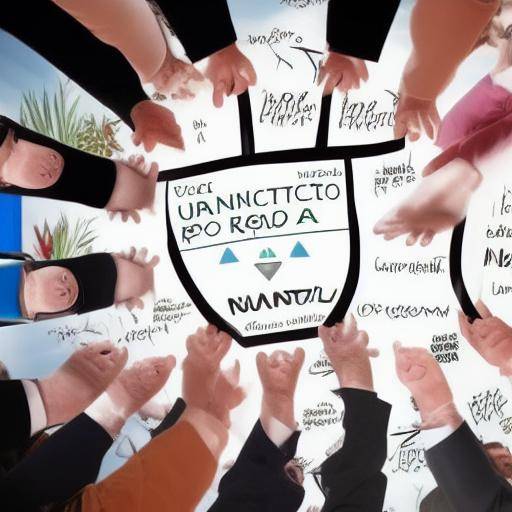
The crowdfunding, or collective financing, has revolutionized the way in which entrepreneurs, artists, non-profit organizations and companies get resources for their projects. Through online platforms such as Kickstarter, Indiegogo and GoFundMe, it is possible to attract the attention of the public and get the financial support necessary to carry out innovative ideas. In this article, we will explore in detail the strategies to get financing through crowdfunding, including the necessary resources and the key elements to achieve success. From the history and evolution of crowdfunding to practical advice, case studies and future predictions, this article will provide an integral insight into this fascinating form of funding.
History and Background of Crowdfunding
The crowdfunding, in its modern form, has experienced significant growth in recent decades, but its roots go back to collective financing practices dating back centuries. From the collection of funds for artistic projects in the Renaissance to the subscriptions of newspapers in the nineteenth century, the concept of collective financing has evolved over time. In the digital era, the emergence of online platforms has further democratized access to financing, allowing individuals from around the world to contribute to projects that encourage them. Over the years, crowdfunding has proven to be a powerful tool for innovation and empowerment of entrepreneurs and creatives.
Significant Developments and Daughters
Over the years, crowdfunding has experienced significant milestones, from the emergence of the first online platforms to projects that have achieved massive success. The year 2009 marked a turning point with the launch of Kickstarter, a platform that enabled creators to present projects and receive financial support from the community. This milestone laid the foundations for a wave of innovation and creativity driven by crowdfunding. More recently, cases such as the record funding of the Oculus Rift campaign in 2012 or the success of the Pebble Time campaign in 2015 have demonstrated the impact and potential of crowdfunding to boost innovative projects.
Detailed Analysis
The crowdfunding offers many benefits, such as access to financing without relying exclusively on traditional investors, early validation of ideas through the interest of the public and the possibility of creating a community around a project from its early stages. However, it also presents challenges, such as the need for a strong marketing strategy, managing the expectations of sponsors and competition in an increasingly saturated market. Understanding these aspects is crucial to maximizing the potential of crowdfunding. In addition, the current trend indicates continuous growth in the crowdfunding industry, with greater diversification of projects and a greater emphasis on transparency and community participation.
Comprehensive review
Success in crowdfunding is based on deep understanding of best practices, effective strategies and market trends. The creation of an attractive campaign that connects emotionally with the audience, the clear definition of financial goals and transparent communication are essential elements. Also, the choice of the right platform, the planning of rewards attractive to sponsors and the construction of a sound dissemination strategy are key aspects to achieving success. However, it is important to note that crowdfunding is not a fast and guaranteed solution, and requires constant effort and a deep understanding of market dynamics.
Comparative analysis
By exploring the concepts of collective, resources and success in the context of crowdfunding, it is possible to identify similarities and significant differences. The concept of collective is related to the collaboration and participation of multiple individuals in support of a project, which is fundamental in crowdfunding. On the other hand, resources refer to the assets, skills and knowledge available to carry out a project, and in the context of crowdfunding, it expands to include the ability to mobilize a community around a cause or idea. Finally, success in crowdfunding is defined by achieving financial goals, meaningful community participation and the ability to carry out the project effectively. By comparing these elements, it is possible to examine how they intertwine and influence each other in the context of collective financing.
Practical Tips and Accessible Tips
By embarking on a crowdfunding campaign, it is crucial to have a solid strategy supported by practical advice and concrete actions. Some recommendations include:
- Deeply know the target audience and develop a proposal that resonates with their interests and values.
- Establish realistic financial targets, considering project costs, rewards for sponsors and campaign-related expenditures.
- Include an attractive video that tells a compelling story and clearly visualizes the project and its impact.
- Planning a strong marketing campaign that uses multiple channels and strategies to reach the audience.
- Keep a constant and transparent communication with the sponsors, offering regular updates and answering your questions and comments.
- Offer attractive and original rewards that encourage sponsors to participate in the campaign.
- Consider strategic alliances with other companies or influencers that can promote the campaign to a relevant audience.
Industry Perspectives and Expert Reviews
Industry perspectives and expert opinions provide a valuable insight into emerging trends and effective strategies in the crowdfunding world. According to experts in the field, crowdfunding is expected to continue to grow in diversity and scope, covering areas that go beyond technology and creative arts. Transparency and authenticity will be increasingly valued by the sponsors, which will require a genuine and committed approach on the part of project creators. In addition, the mobilization of communities and the creation of meaningful experiences for the sponsors will become key elements for achieving success in crowdfunding in the coming years.
Case Studies and Practical Applications
Real case analysis and practical applications offer a tangible perspective on crowdfunding results and challenges. From innovative technological projects to cultural and social initiatives, case studies provide concrete examples of how collective financing has led to the realization of ideas. In addition, analyzing the long-term impact of these projects and learning from successful strategies, as well as the challenges encountered, can offer valuable lessons for those seeking to embark on crowdfunding campaigns.
Future Trends and Predictions
Future trends and predictions allow us to glimpse the way ahead in the crowdfunding arena. With continuous technological advances, crowdfunding platforms are expected to evolve to provide more sophisticated tools for campaign management and interaction with sponsors. The integration of blockchain and other emerging technologies could also transform transparency and security into collective financing. In addition, more collaboration is envisaged between crowdfunding projects, the emergence of new financing models and greater attention to sustainability and social impact as critical criteria for community support.
Conclusion
The crowdfunding represents a transformative force in the world of financing, offering an alternative and powerful way to materialize innovative projects. From its historical evolution to practical strategies and future predictions, this article has provided a complete view of strategies to get funding through crowdfunding. By understanding the intersection between collective financing, available resources and expected success, entrepreneurs, creatives and exchange agents can move confidently towards the realization of their projects.
Frequently asked questions
1. What is crowdfunding and how does it work?
The crowdfunding is a method through which individuals or companies can raise money to finance projects by obtaining small contributions from a large number of people. It works by presenting a project on an online platform, where interested sponsors can make contributions in return for rewards or simply by supporting the initiative.
2. What are the resources needed for a successful crowdfunding campaign?
The resources needed for a successful crowdfunding campaign include a strong marketing strategy, the ability to mobilize a community, effective communication skills, knowledge about how to use the chosen crowdfunding platform and the ability to offer attractive rewards for sponsors.
3. What difference does the crowdfunding of traditional financing make?
The main difference lies in the source of financing: while traditional financing comes from individual financial institutions or investors, crowdfunding is based on the support of a large number of people who contribute with smaller amounts.
4. What are the most common challenges in crowdfunding?
Some of the most common challenges include competition in a saturated market, the need to maintain constant communication with sponsors, the clear definition of realistic financial goals and the management of community expectations.
5. What is the role of the community in crowdfunding?
The community plays a key role in crowdfunding, as its participation and financial support are key to the success of a campaign. Mobilizing the community, generating interest and maintaining effective communication with the sponsors are fundamental aspects.
6. What are future trends in crowdfunding?
Future trends in crowdfunding include greater project diversification, the integration of emerging technologies such as blockchain, greater attention to sustainability and social impact, and the evolution of platforms to provide more sophisticated campaign management tools.
With these key elements, as a collective, resources and success, crowdfunding continues to prove to be a transformative force in the financing landscape. By fully understanding its dynamics and possibilities, it is possible to make the most of its advantages and achieve success in the realization of innovative projects.






















































